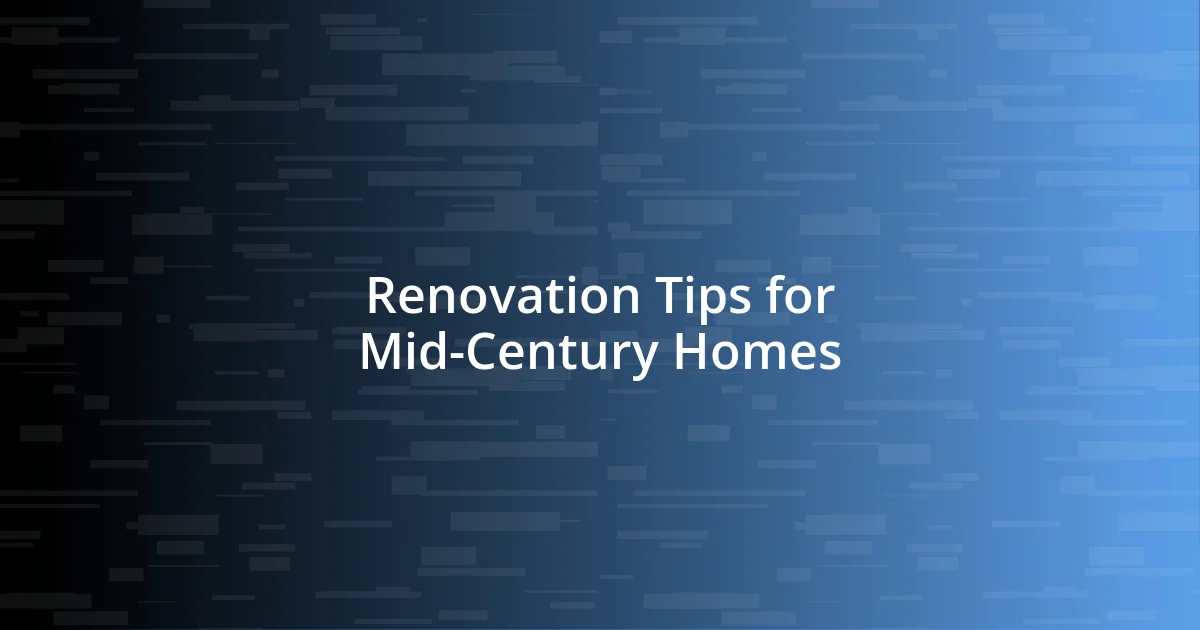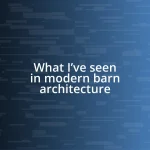Key takeaways:
- Mid-century homes emphasize harmony with nature, featuring large windows and open floor plans that create a seamless indoor-outdoor living experience.
- Common challenges include outdated plumbing and electrical systems, the need for maintenance of original materials, and structural issues due to age.
- Preserving the authenticity of mid-century design is crucial, focusing on energy efficiency while honoring original architectural elements and sourcing vintage materials.

Introduction to Mid-Century Homes
Mid-century homes, often characterized by their sleek lines and integration with nature, captivate my imagination with their nostalgic charm. I remember visiting a friend’s mid-century residence, where the expansive windows seemed to invite the outdoors in, creating a seamless blend of indoor and outdoor living. Have you ever experienced a space that just felt effortlessly calming?
These homes emerged in the post-World War II era, a time of innovation and a shift in design philosophy that prioritized simplicity and functionality. To me, it’s fascinating how these structures, with their open floor plans and minimal ornamentation, embody a sense of freedom. They invite us to live more casually and comfortably, a reflection of the lifestyles people aspired to in that era.
What truly sets mid-century homes apart is their celebration of nature and light. I often find myself dreaming of a sun-drenched room framed by earthy tones and natural materials, a stark contrast to today’s fast-paced, technology-driven living. Isn’t there something irresistibly appealing about a design that not only looks good but feels good, too?

Key Features of Mid-Century Design
The key features of mid-century design reflect a harmonious balance of form and function. I often notice how open floor plans encourage a natural flow between rooms, making spaces feel larger and more connected. It reminds me of my own home, where hosting friends feels effortless thanks to the easy transition from the living area to the kitchen. Each element seems to have been chosen not just for aesthetics, but for creating an inviting atmosphere.
Some defining characteristics of mid-century design include:
- Large Windows: Allowing abundant natural light to flood the interior.
- Integration with Nature: Designed to blend seamlessly with the surrounding environment.
- Flat and Low-Pitched Roofs: Offering a unique silhouette and reinforcing the connection to the landscape.
- Simple Forms: Emphasizing clean lines and geometric shapes.
- Functionality: Designing spaces that cater to everyday living without unnecessary clutter.
These features not only captivate but also resonate deeply with the way I believe homes should feel—personal and serene.

Common Challenges of Mid-Century Homes
Mid-century homes, while beautiful, come with their fair share of challenges. One common issue is outdated plumbing and electrical systems. I recall a friend who purchased a lovely mid-century house, only to discover that the wiring didn’t meet modern safety standards. This not only forced costly updates but also disrupted their plans to settle in quickly. Have you ever experienced such a surprise with home renovations?
Another challenge is the maintenance of materials that were popular back then, like asbestos and single-pane windows. I once visited a stunning mid-century estate, where modernizing the windows became a labor-intensive task. The original design called for beautiful large panes of glass, but those single panes were energy inefficient and often prone to drafts. It made me think about how balancing restoration with contemporary comfort can be tricky.
Finally, many mid-century homes face structural issues due to their age. Some homes have settled unevenly over the decades. A family member recently renovated their mid-century gem, only to find they needed significant foundation work. It’s a reminder that while these homes exude charm, understanding their vulnerabilities is essential for any potential homeowner.
| Challenge | Description |
|---|---|
| Outdated Systems | Old plumbing and electrical issues require costly updates, often disrupting home renovation plans. |
| Material Maintenance | Asbestos, single-pane windows, and other outdated materials can complicate modernizing efforts. |
| Structural Issues | Uneven settling and foundation problems may arise, demanding significant renovation work. |

Renovation Tips for Mid-Century Homes
When it comes to renovating mid-century homes, embracing the original architectural elements is crucial. I remember wandering through a neighbor’s updated space where they preserved the iconic exposed beams and open layout, creating a stunning contrast against modern fixtures. These touches brought such warmth and character, making me think: how can we honor the unique features while infusing our personal style? It emphasizes the beauty of collaboration between old and new.
One important tip is to focus on energy efficiency without compromising the home’s essence. For instance, when I renovated my own mid-century kitchen, I replaced the old single-pane windows with double-glazed alternatives that maintained the original design aesthetics. It was a relief to see an immediate reduction in energy costs, and it felt rewarding to protect the vintage vibe while making practical upgrades. Have you thought about sustainable options that still respect the past?
Lastly, don’t shy away from seeking expert advice when needed. I learned this lesson the hard way while tackling a DIY project on a mid-century home. I attempted to replace outdated electrical systems myself, only to discover I was in over my head. Hiring a qualified electrician not only saved me time but also prevented potential safety hazards. It made me wonder, what’s more important—saving a few bucks or ensuring a safe, functional living space? Trusting professionals can often lead to better results and peace of mind in the long run.

Preserving the Authenticity of Design
To truly preserve the authenticity of mid-century homes, I believe it’s essential to honor the original design choices crafted by visionary architects. For instance, I was fortunate enough to attend a home tour of a beautifully preserved mid-century property, and the strong connection between the indoor and outdoor spaces struck me. The large windows and open layouts invited nature inside while maintaining a sense of unity with the surroundings, showcasing that staying true to the original design pays off.
When contemplating renovations, it can be tempting to gravitate toward trendy updates, but I feel that it’s vital to engage with the character of the original home. I once helped a friend select paint colors for her mid-century living room. Instead of opting for a modern palette, we chose hues inspired by the era, which made the space feel refreshed yet authentic. This experience reminds me: how can we enhance a home while still respecting its heritage?
Furthermore, I’ve found that sourcing original materials, whenever possible, plays a significant role in maintaining the home’s integrity. During a recent visit to a historical restoration shop, the excitement of discovering original tile samples fascinated me. I asked myself, what stories might they hold? Incorporating such elements into renovations can evoke nostalgia and personalize the space, making it more than just a house, but a home filled with history.

Personal Reflections on Mid-Century Living
Living in a mid-century home is like stepping into a dream world. When I first walked into my friend’s house, I was captivated by the warm wood paneling and the way the sunlight streamed through those expansive glass doors. It felt as if the house was inviting the outdoors in, a concept that just resonates with me deeply. Don’t you think there’s something special about a space that can so seamlessly merge with nature?
Reflecting on my experiences, I find mid-century living evokes a sense of nostalgia that often escapes our fast-paced lives. I remember hosting a small gathering in my own mid-century living room, surrounded by iconic furniture pieces and vibrant artwork from the era. It struck me how the unique design sparked conversations and laughter—the space had a life of its own! Have you noticed how certain homes can influence the mood and energy of gatherings? It’s almost magical.
In contemplating the essence of mid-century living, I’ve grown increasingly aware of the memories created within these walls. I often sit by the fireplace, reveling in its warmth, and I can’t help but think about the countless stories it has witnessed. Each crackle of the fire seems to whisper tales of families who’ve inhabited this space. Isn’t it enriching to live somewhere that carries such a rich history? It’s these reflections that truly connect me to the character of mid-century homes.














